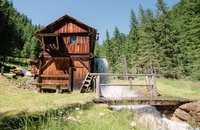
9932 Innervillgraten
Building culture, innovation and rural work culture are the content of the facilities in the area at the entrance to the Arntal in Innervillgraten. The Lodenstampf, mill, Einhof, alpine hut and entrance house have been built, remodelled and renovated in recent months and years. The development of the open-air museum began with the restoration of the Wegelate Säge, the centrepiece of the ensemble, which was built in 1883. Interested visitors can experience the restored stations - especially the listed Wegelate Sawmill as the last Venetian sawmill in Austria - on guided tours and immerse themselves in the fascinating history of Alpine life in Innervillgraten.
July to 20 September Demonstrations 2024:
The demonstrations take place on Tuesday at 3.00 pm and on Thursday at 10.00 am.
Ticket price € 15,- for adults, children's ticket up to 14 years 50%, up to 6 years free.
Group price - up to 25 persons € 10,- per person, from 26 pers. € 8,- per person, chauffeur and tour guide free of charge
Opening hours 2024:
In July and August, the open-air museum is open on Wednesday, Friday and Sunday from 10.00 - 16.00 (no demonstrations).
The objects are closed, the area is open, where videos and information boards are available. Ticket price € 5,- per person.
Lots of sunshine, a wonderful view of the mountains around the Lienz valley floor - Oberlienz is without doubt a particularly beautiful place. The sunny village also has an impressive cultural landscape to offer. If you are out and about on the well-maintained hiking trails, you are sure to notice the so-called "Feldgröfelmauern" in the meadows. These are dry stone walls, piled up from stones and rubble that once reached the fields through the Schleinitzgraben with mudslides, avalanches and so on. If you walk along the Schleinitzbach stream in the village center, you are basically already in the middle of the Oberlienz open-air museum, which consists of an ensemble of various historical buildings. They give an impression of life and farming in the region.
At the upper end of the open-air museum, you first come across the Bad- und Brechelstube, where flax was roasted and broken until the early 1950s. Alongside sheep's wool, flax fibers formed the basis of all textiles used in rural life. The washed wool ran through wooden rollers and iron pins in the wool carding machine further down, which was driven by a paddle wheel - this is how it was cleaned and made ready for spinning.
Fruit and potatoes were once stored on the open floor in the granary, along with field and garden crops and barrels of cabbage. The village grain store was located on the floor above.
The grain mill of the "Znopp" hereditary farm is also part of the open-air museum ensemble. Grain was ground here and processed into animal feed using a clover crusher. The large hammer in the farmyard and hardware forge further down was also driven by a water wheel, with a sophisticated system regulating the air supply for the bellows.

Text